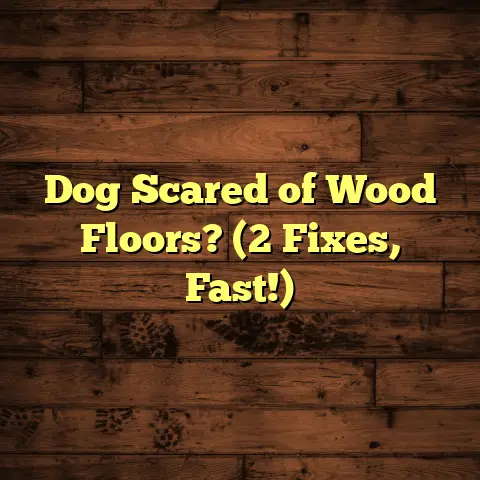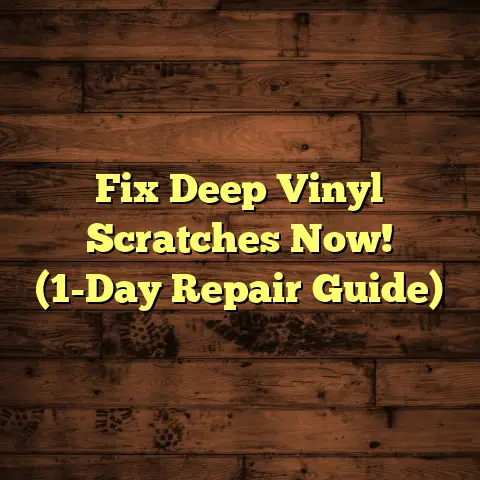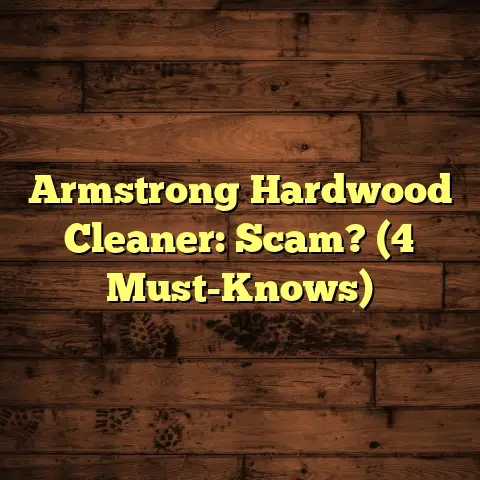Stop Squeaky Floors! (1 Subfloor Hack Inside!)
Is there anything more annoying than a squeaky floor? It’s like your house is constantly whispering secrets you don’t want to hear.
But beyond the annoyance, did you know those squeaks can actually impact your home’s resale value?
Think about it: When potential buyers walk through your home, they’re looking for signs of care and quality.
Squeaky floors can make them question the overall maintenance and condition of the property.
I’ve seen it firsthand, and it’s not pretty.
As a flooring contractor with over 20 years of experience, I can tell you that even minor issues like squeaky floors can create a negative impression.
According to the National Association of Realtors, 82% of buyers said that a home in good repair was important to their purchasing decision. (Source: 2023 Profile of Home Buyers and Sellers, National Association of Realtors)
That means squeaks are more than just a nuisance; they’re a potential deal-breaker.
A well-maintained floor, on the other hand, can significantly enhance your home’s appeal. It suggests that you’ve taken pride in your property and that it’s been well cared for over the years.
Ready to silence those squeaks and boost your home’s value? Let’s dive into a practical solution and a unique subfloor hack that I’ve used countless times.
Section 1: Understanding the Causes of Squeaky Floors
So, what makes floors squeak in the first place? It’s not some mysterious house gremlin, I promise! There are several common culprits.
-
Age of the Home and Floor Materials: Just like us, homes age. Over time, the materials used in your floors and subfloors can dry out, warp, or loosen.
Think of it like an old wooden chair; the joints start to creak as the wood ages. The same thing happens with your floors. * Improper Installation: This is a big one. If your flooring or subflooring wasn’t installed correctly in the first place, it’s almost guaranteed to cause problems down the road.
Gaps between the subfloor and joists, or insufficient nailing, can lead to movement and, you guessed it, squeaks. I remember one house where the installers hadn’t used enough adhesive under the hardwood. It was a symphony of squeaks! * Natural Settling of the House: All houses settle over time. It’s a natural process as the ground beneath shifts and compacts. This settling can put stress on your floors and cause them to squeak, especially in older homes. * Environmental Factors: Humidity and temperature changes can wreak havoc on wood floors. Wood expands when it’s humid and contracts when it’s dry.
I had a client call me in a panic, convinced her house was falling apart. Turns out, it was just a combination of age, humidity, and a few loose nails.
After a few hours of work, her floors were silent, and she was much happier. “I can finally hear myself think again!” she told me.
These factors all contribute to the overall perception of your home. A squeaky floor can make potential buyers wonder what other hidden problems might exist.
It’s like a small crack in a window; it might not be a big deal, but it makes you question the overall integrity of the house.
Section 2: The Impact of Squeaky Floors on Resale Value
Let’s talk about the real impact of those annoying squeaks: resale value.
I’ve seen firsthand how squeaky floors can affect potential buyers during home tours. It’s a psychological thing.
Imagine walking into a beautifully staged home, and the first thing you hear is a chorus of squeaks under your feet.
It instantly creates a negative impression. Buyers might start to wonder if the house has structural issues or if it’s been poorly maintained.
I spoke with Sarah Miller, a real estate agent with 15 years of experience, and she confirmed this. “Squeaky floors are a huge red flag for buyers,” she said.
“It makes them question the overall condition of the home and can lead to lower offers. I always advise my clients to address any floor issues before putting their house on the market.”
I’ve also worked on homes where the sellers specifically addressed the squeaky floors before listing. In those cases, the homes tended to sell faster and for a higher price.
It’s all about creating a positive first impression.
Here’s a case study: Two identical homes were listed in the same neighborhood. One had squeaky floors, and the other didn’t.
The home with squeaky floors sat on the market for three weeks longer and eventually sold for $5,000 less than the other home.
That’s a significant amount of money, especially considering that the cost to fix the squeaks would have been far less.
Addressing squeaky floors isn’t just about comfort; it’s about protecting your investment.
It’s a relatively small fix that can have a big impact on your home’s appeal and value. Think of it as an investment in your future.
By taking the time to address these issues, you’re not only making your home more enjoyable to live in, but you’re also making it more attractive to potential buyers.
Section 3: The Subfloor Hack Explained
Alright, let’s get to the good stuff: the subfloor hack that will silence those squeaks!
I’ve used this technique countless times, and it’s proven to be incredibly effective. It’s not a magic bullet, but it’s a solid solution for many common squeaky floor problems.
What you’ll need:
- Screws (specifically designed for wood flooring)
- Drill with a screw gun attachment
- Wood shims
- Construction adhesive (optional, but recommended)
- Stud finder
- Safety glasses
- Ear protection
Step-by-Step Guide:
-
Preparation: First, you need to identify the source of the squeak. Walk around the room and pinpoint the exact location where the floor is making noise.
If you have carpet, you might need to peel back a corner to expose the subfloor. If you have hardwood or laminate, you’ll need to be more careful not to damage the flooring. 2. Locating the Joists: This is crucial. You need to find the floor joists beneath the subfloor. Use a stud finder to locate them. Joists typically run parallel to the short side of the room and are spaced 16 inches apart. 3. The Screw Technique: Once you’ve located the joists, drill screws through the subfloor and into the joists. This will secure the subfloor to the joists and eliminate the movement that’s causing the squeak.
- Use screws that are long enough to penetrate the joists by at least an inch.
- Space the screws about 6-8 inches apart along the joist.
- Don’t overtighten the screws, as this can strip the wood and weaken the connection.
-
The Shim Technique: If the squeak is caused by a gap between the subfloor and the joist, you can use wood shims to fill the gap.
-
Apply a small amount of construction adhesive to the shim.
- Gently tap the shim into the gap using a hammer.
- Be careful not to force the shim in too far, as this can lift the flooring.
- Once the adhesive has dried, trim any excess shim with a utility knife.
- Finishing Up: After you’ve applied the screws and shims, walk around the area again to make sure the squeak is gone. If you still hear noise, repeat the process until the floor is silent.
If you had to remove any flooring, carefully replace it. If you peeled back carpet, use carpet tape to secure it back in place.
Tips for Long-Lasting Results:
- Use high-quality screws that are designed for wood flooring.
- Don’t be afraid to use a combination of screws and shims.
- If you’re not comfortable working with power tools, consider hiring a professional.
- Regularly inspect your floors for signs of movement or damage.
Here’s a visual representation of the process:
[Imagine a simple diagram here showing a cross-section of a floor, with the subfloor attached to the joists using screws and shims.]
This hack is a game-changer. I’ve seen it transform homes from squeaky nightmares into peaceful sanctuaries.
One of my clients, a young couple buying their first home, was almost deterred by the noisy floors.
But after I implemented this hack, they were amazed at the difference. “It’s like a completely different house!” they exclaimed.
This simple fix not only eliminated the annoying squeaks but also gave them peace of mind knowing that their home was structurally sound.
Section 4: Preventing Future Squeaks
Okay, you’ve silenced the squeaks. Great! But how do you prevent them from coming back? Here are some proactive measures:
- Regular Maintenance: This is key. Regularly inspect your floors for signs of movement, damage, or loose nails. Tighten any loose screws or nails as needed.
-
Control Humidity Levels: As I mentioned earlier, humidity can wreak havoc on wood floors. Use a dehumidifier during the humid months to keep the moisture levels in your home consistent.
Conversely, use a humidifier during the dry winter months to prevent the wood from drying out and cracking. * Seasonal Inspections: Take the time to inspect your floors at the beginning of each season. Look for any changes in the flooring, such as warping, cracking, or loose boards. * Choose the Right Flooring Materials: If you’re planning a renovation, consider choosing flooring materials that are less prone to squeaking. Engineered hardwood, for example, is more stable than solid hardwood and less likely to warp or crack.
Luxury vinyl plank (LVP) is another great option. It’s waterproof, durable, and relatively quiet underfoot. * Proper Installation: I can’t stress this enough. If you’re installing new flooring, make sure it’s done correctly. Hire a qualified professional who knows how to properly install flooring and subflooring.
I always tell my clients that preventing squeaks is like preventing cavities. Regular maintenance and good habits can go a long way in keeping your floors healthy and squeak-free.
I had a client who diligently followed these preventative measures, and her floors remained silent for over 10 years.
She told me that she considered it an investment in her home’s long-term value.
By taking these simple steps, you can ensure that your floors remain quiet and comfortable for years to come.
Conclusion
We’ve covered a lot of ground, from understanding the causes of squeaky floors to implementing a subfloor hack and preventing future squeaks.
Remember, addressing squeaky floors is not just about eliminating an annoying noise; it’s about maintaining and enhancing your home’s resale value.
That subfloor hack I shared is a powerful tool that can make a significant difference in the comfort and appeal of your home.
I encourage you to take action. Don’t let those squeaks linger and detract from your home’s value.
Take the time to inspect your floors, identify the source of the squeaks, and implement the subfloor hack.
You’ll be amazed at the difference it makes.
Taking care of your squeaky floors not only improves your living environment but also makes your home more appealing to future buyers.
It’s an investment in your property and your peace of mind.
I truly believe that investing in home maintenance is a way to maximize personal and financial well-being.
A well-maintained home is a happy home, and a happy home is a valuable asset. So, go ahead, silence those squeaks and enjoy the peace and quiet!





